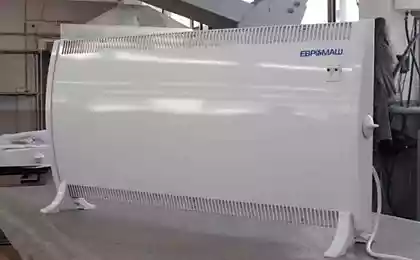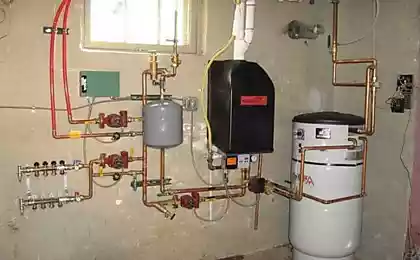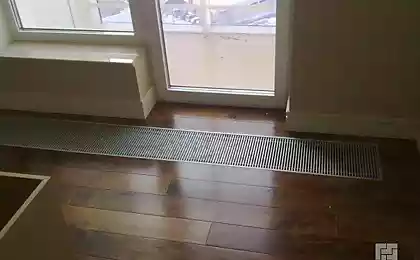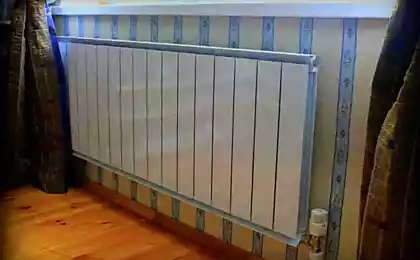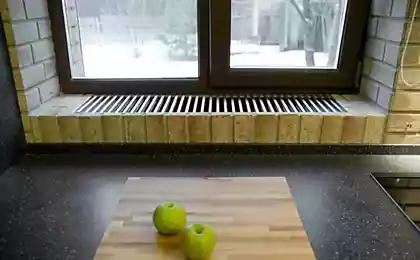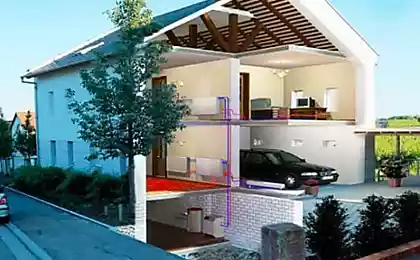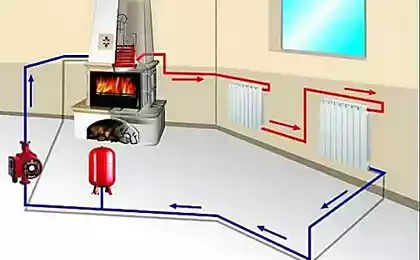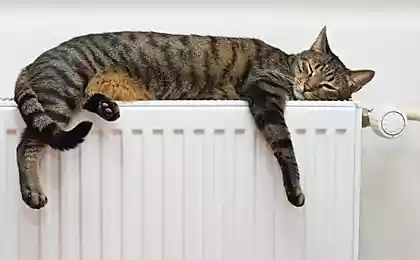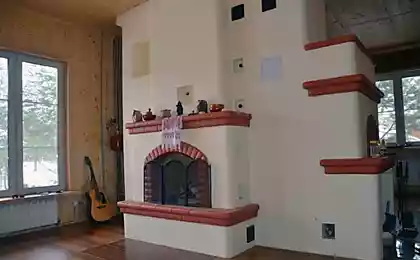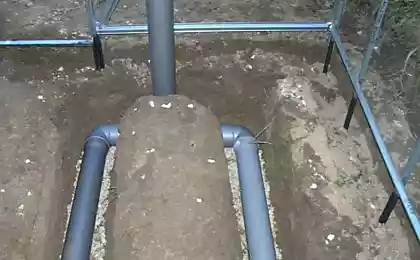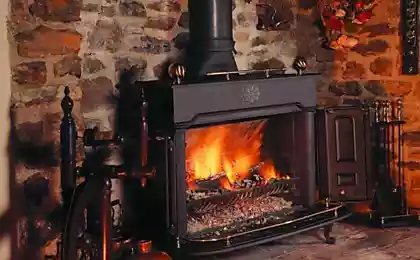599
Radiators and convectors heating integrated in the floor
In modern engineering and technical equipment of residential buildings one of the key trends is the invisibility of telecommunications. We propose to examine the sources of heat, embedded in the floor, to see the effectiveness of their work and the basic rules of installation.
Why incorporate heaters in the floorDue to the structural and architectural features not every building allows for the possibility of installing wall heaters on the enclosing structures. Basic restrictions:
The wall material and sufficient for reliable surface mounting thickness. Circuit wiring communications. Need solid finishes from floor to ceiling. In addition to solving purely technical problems, there are more practical aspects. It is, first and foremost, the invisibility of the heating system. The main advantage of under-floor convectors in front of the radiant heating systems you can call them high power to compensate for even a very significant heat loss.
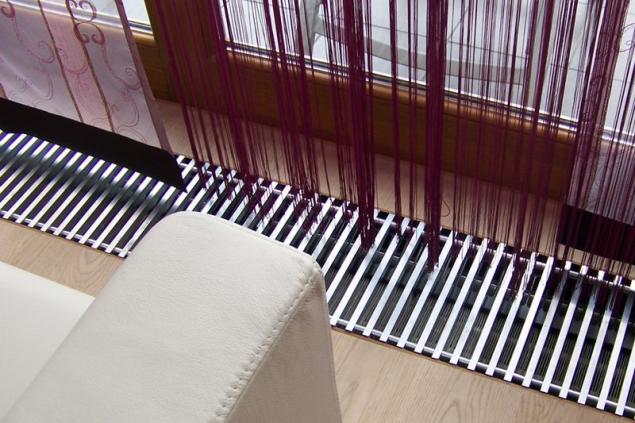
The scheme of distribution of heat from floor convectors also compares favorably with the wall. Paul is not formed in the cold zone unheated, the temperature rise with the ascent of the hot air is much less pronounced. Embedded in the floor convectors are very easy to use, but to install them you will have to invest in the engineering building quite a large sum of money.
Varieties of trench convectorsthe trench heaters Cost much higher in comparison with other heating devices. The only exception is the split-system air-pumps, which, incidentally, also used in outdoor heaters.
How much have to pay for outdoor heater? The price depends on a number of criteria:
The size of the convector. Its power density, i.e. heat 1 TDG. M. Method of thermostatic regulation. The presence of air blower. The quality and country of origin.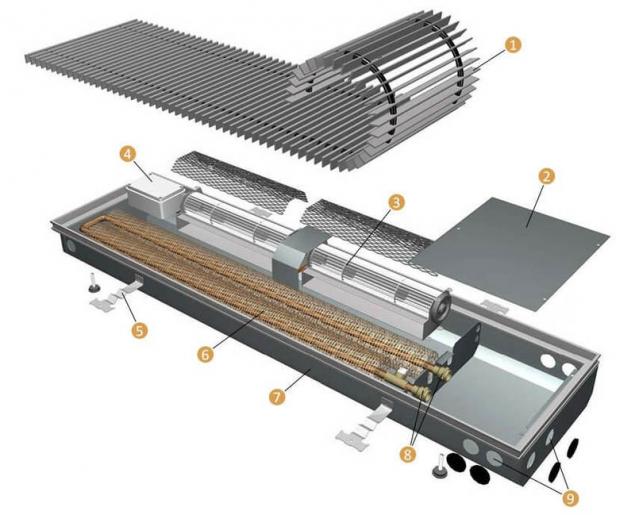
Design a trench heater: 1 — grille; 2 — protective cover camera connection; 3 — tangential fan; 4 — block the electrical connection; 5 — fasteners; 6 — heat exchanger; 7 — the body of the convector; 8 — connections; 9 — holes for connection
With the aid of convectors in the floor to create a thermal curtain of virtually unlimited length, although some sections are rare exceptions in length not exceed 3 meters. In width on average, the heaters take about 200 mm without forced air flow and about 300-400 mm in the presence of such.
The specific heat under-floor convectors ranges from 0.3 to 1 kW per meter. At a cost of every kilowatt of power is equivalent to the amount of 10-15 thousand rubles for domestic products and 30 thousand rubles for imported equipment. The presence of forced air flow slightly increases the cost, but significantly increases heat transfer.

For convenience mounted in the floor convectors can be supplied with automatic regulators of flow and intensity of air exchange, although most rank and file models simply equipped with shutoff or control valves. Also there is a difference in heat source to heat the air, it may be the coolant water heating system or electricity. In the latter case, temperature adjustment can be performed both cutoff and automatic adjustment of power under the current mode of operation.
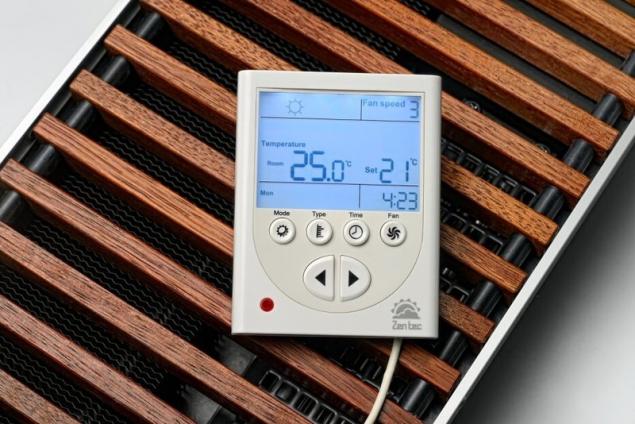
Applicationsthe Most obvious situation where for under-floor convectors almost no alternatives is the necessity of heating large fronts of glass, attached to the floor of the room. The presence of even 20-30 cm parapet under a glass window would have made possible the installation of much cheaper devices for wall mounting.
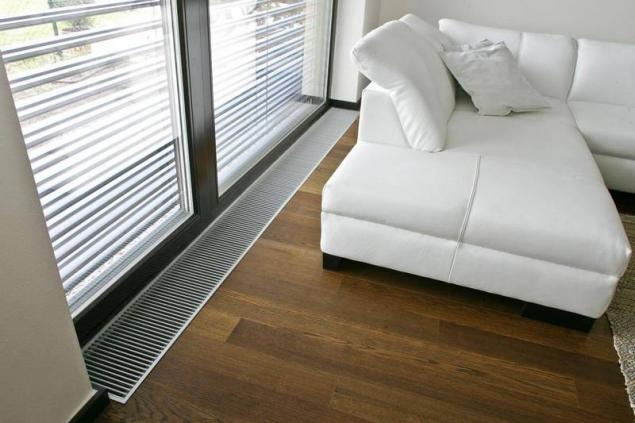
The system of floor in this case does not particularly help to solve the problem, because any glazing at times inferior to the major barriers of resistance to heat transfer. Thanks to outdoor heaters can be efficient cold air intake from under the window or door, heat it and circulate to the inhabited room volume. There are, however, outdoor heaters, leading to the air intake from the street, their application should be consistent with the mode of ventilation.
Also embedded in the floor convectors are very useful for making thermal curtains in front of doors leading to outdoor terraces and other spaces associated with the street. In such cases, the basic calculation is not for the compensation of heat losses, and the ability to make the entry of people in the room more comfortable.
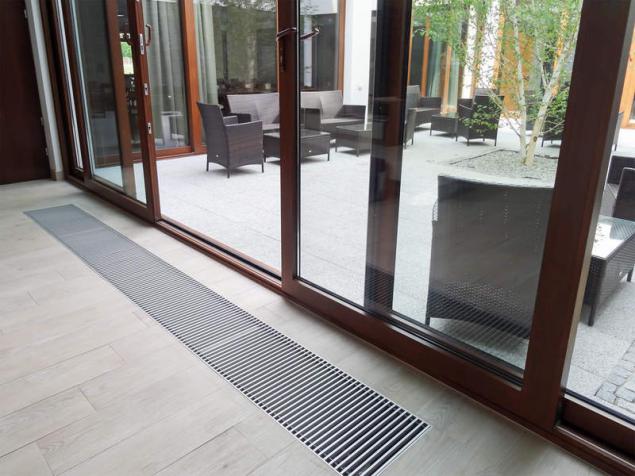
If desired and appropriate financial capabilities of a trench convectors can be substituted for all other heaters. The considered device does not form the extreme temperatures in the zone of direct contact, and therefore, even for leather furniture that is installed in close proximity, stored optimum operating conditions.
The complexity of the hydraulic connectionsthe installation of electric heaters is limited to their accurate incorporation into the floor and joining the flooring, for heat exchangers with liquid coolant to properly organize the wiring diagram for the heating system.
The point of tie-in pipelines that feed the heaters must be located as close as possible to the boiler or entering the hot coolant into the apartment. Permissible operating temperature of most heaters is slightly higher than 100 ºC. Almost all types of vehicles capable of operating when connected to the centralized heating systems with working pressure up to 10 ATM (at the height of the building to 9-12 floors). For systems with higher water column should be used the device can withstand up to 14-16 ATM.
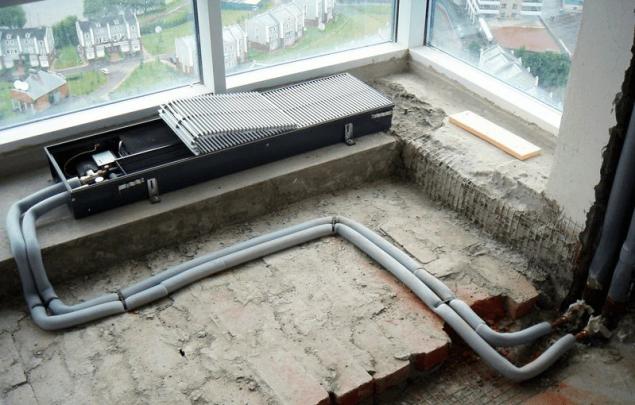
Connection of the convector to the findings of the pipes takes place entirely inside the installation box. Accordingly, the length of the bends must allow zapressovku coupling fittings for the connection, plus a small margin. Package most models of outdoor heaters includes a small bellows hoses, removing the need for fine adjustment of the length of the branches. There are also tee, or straight threaded connection, intended for connection of heaters in a parallel bundle, or separately.
The entire piping of the heat exchanger provided by the manufacturer and functionality of the device, factory mounted. The convector can be already built in valve bleed air regulator duct or valve with electric actuator, but they can be installed during the connection process. If necessary, the heater can be supplemented with on-off or control valves — inside the box for plenty of space. For more convenient use of flow regulators can be put to a collector node, but only if each heater connected to a separate pair of tubes.
The technique of embeddingthe Embedding of the convector can be performed on the stage of pouring concrete subfloor. Included with many devices are protective covers that preserve the integrity technical ducts during concrete works. Just enough to wrap the heater thin insulating material, which will provide cutoff of the heat and facilitate dismantling in case of repair or replacement.
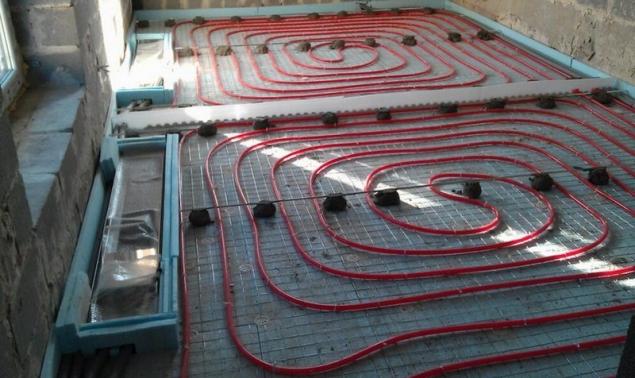
More technologically advanced method of embedding — the early regeneration niche, is certainly greater in size than the housing of the heater. In this case the convector is much easier to align in the plane of the floor covering and to provide guidance with respect to the walls or other stationary objects. The correct position provided leveling feet and mounting system to the bottom floor, proactive surfacing or displacement of the box when it semerovce.
An additional advantage of the latter method of embedding can be called the use of cement mortar with fine porous filler, which helps to reduce heat leakage. This is especially important if on adjacent areas of the floor are not fitted with heating. After attachment to the base and filling gaps with a mixture of liquid consistency is to remove the safety caps and spacers that hold the housing wall from being crushed.
The final step is trimming of the findings of the pipes and the connection of the convector in the overall system. The upper edge of the box for the majority of the models presented decorative area, which provides easy laying of the protective lattice and the aesthetic abutment to the floor finish without the use of end sills.
Maintenance and repairIn the operation process heaters collect a sufficiently large amount of dust, which is abundantly present in the lower area of the room, where is the air intake. To this the dust does not spread throughout the heated space heaters are equipped with quality air filters and traps dust. Cleaning is the service of the convector, is a little less adjustment, and performance tuning.
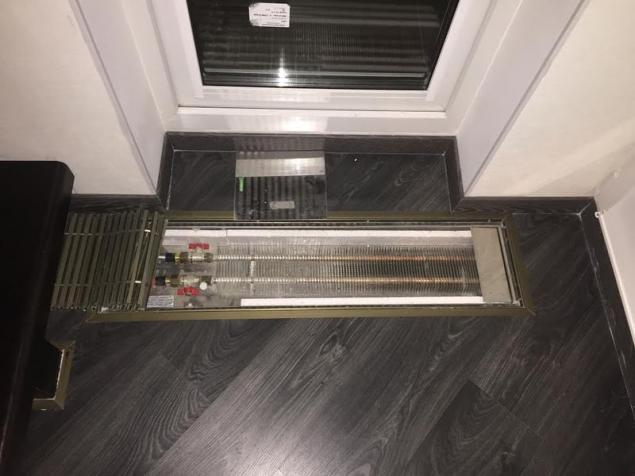
Heat exchanger embedded in the floor convectors are made from high quality materials with a polished inner surface, which is not observed the deposition of solid impurities. When flushing the heating system it is recommended that the device be disconnected from the system, and feeding tubes — short circuiting.
Most representatives of this type of heating technology, especially foreign, is a modular unit. If necessary, any part can be harmless to dismantle and return to the place, which is very convenient, for example, if the failure happened a blower or the control system. published
P. S. And remember, only by changing their consumption — together we change the world! ©
Source: //www.rmnt.ru/story/heating/1322210.htm
Why incorporate heaters in the floorDue to the structural and architectural features not every building allows for the possibility of installing wall heaters on the enclosing structures. Basic restrictions:
The wall material and sufficient for reliable surface mounting thickness. Circuit wiring communications. Need solid finishes from floor to ceiling. In addition to solving purely technical problems, there are more practical aspects. It is, first and foremost, the invisibility of the heating system. The main advantage of under-floor convectors in front of the radiant heating systems you can call them high power to compensate for even a very significant heat loss.

The scheme of distribution of heat from floor convectors also compares favorably with the wall. Paul is not formed in the cold zone unheated, the temperature rise with the ascent of the hot air is much less pronounced. Embedded in the floor convectors are very easy to use, but to install them you will have to invest in the engineering building quite a large sum of money.
Varieties of trench convectorsthe trench heaters Cost much higher in comparison with other heating devices. The only exception is the split-system air-pumps, which, incidentally, also used in outdoor heaters.
How much have to pay for outdoor heater? The price depends on a number of criteria:
The size of the convector. Its power density, i.e. heat 1 TDG. M. Method of thermostatic regulation. The presence of air blower. The quality and country of origin.

Design a trench heater: 1 — grille; 2 — protective cover camera connection; 3 — tangential fan; 4 — block the electrical connection; 5 — fasteners; 6 — heat exchanger; 7 — the body of the convector; 8 — connections; 9 — holes for connection
With the aid of convectors in the floor to create a thermal curtain of virtually unlimited length, although some sections are rare exceptions in length not exceed 3 meters. In width on average, the heaters take about 200 mm without forced air flow and about 300-400 mm in the presence of such.
The specific heat under-floor convectors ranges from 0.3 to 1 kW per meter. At a cost of every kilowatt of power is equivalent to the amount of 10-15 thousand rubles for domestic products and 30 thousand rubles for imported equipment. The presence of forced air flow slightly increases the cost, but significantly increases heat transfer.

For convenience mounted in the floor convectors can be supplied with automatic regulators of flow and intensity of air exchange, although most rank and file models simply equipped with shutoff or control valves. Also there is a difference in heat source to heat the air, it may be the coolant water heating system or electricity. In the latter case, temperature adjustment can be performed both cutoff and automatic adjustment of power under the current mode of operation.

Applicationsthe Most obvious situation where for under-floor convectors almost no alternatives is the necessity of heating large fronts of glass, attached to the floor of the room. The presence of even 20-30 cm parapet under a glass window would have made possible the installation of much cheaper devices for wall mounting.

The system of floor in this case does not particularly help to solve the problem, because any glazing at times inferior to the major barriers of resistance to heat transfer. Thanks to outdoor heaters can be efficient cold air intake from under the window or door, heat it and circulate to the inhabited room volume. There are, however, outdoor heaters, leading to the air intake from the street, their application should be consistent with the mode of ventilation.
Also embedded in the floor convectors are very useful for making thermal curtains in front of doors leading to outdoor terraces and other spaces associated with the street. In such cases, the basic calculation is not for the compensation of heat losses, and the ability to make the entry of people in the room more comfortable.

If desired and appropriate financial capabilities of a trench convectors can be substituted for all other heaters. The considered device does not form the extreme temperatures in the zone of direct contact, and therefore, even for leather furniture that is installed in close proximity, stored optimum operating conditions.
The complexity of the hydraulic connectionsthe installation of electric heaters is limited to their accurate incorporation into the floor and joining the flooring, for heat exchangers with liquid coolant to properly organize the wiring diagram for the heating system.
The point of tie-in pipelines that feed the heaters must be located as close as possible to the boiler or entering the hot coolant into the apartment. Permissible operating temperature of most heaters is slightly higher than 100 ºC. Almost all types of vehicles capable of operating when connected to the centralized heating systems with working pressure up to 10 ATM (at the height of the building to 9-12 floors). For systems with higher water column should be used the device can withstand up to 14-16 ATM.

Connection of the convector to the findings of the pipes takes place entirely inside the installation box. Accordingly, the length of the bends must allow zapressovku coupling fittings for the connection, plus a small margin. Package most models of outdoor heaters includes a small bellows hoses, removing the need for fine adjustment of the length of the branches. There are also tee, or straight threaded connection, intended for connection of heaters in a parallel bundle, or separately.
The entire piping of the heat exchanger provided by the manufacturer and functionality of the device, factory mounted. The convector can be already built in valve bleed air regulator duct or valve with electric actuator, but they can be installed during the connection process. If necessary, the heater can be supplemented with on-off or control valves — inside the box for plenty of space. For more convenient use of flow regulators can be put to a collector node, but only if each heater connected to a separate pair of tubes.
The technique of embeddingthe Embedding of the convector can be performed on the stage of pouring concrete subfloor. Included with many devices are protective covers that preserve the integrity technical ducts during concrete works. Just enough to wrap the heater thin insulating material, which will provide cutoff of the heat and facilitate dismantling in case of repair or replacement.

More technologically advanced method of embedding — the early regeneration niche, is certainly greater in size than the housing of the heater. In this case the convector is much easier to align in the plane of the floor covering and to provide guidance with respect to the walls or other stationary objects. The correct position provided leveling feet and mounting system to the bottom floor, proactive surfacing or displacement of the box when it semerovce.
An additional advantage of the latter method of embedding can be called the use of cement mortar with fine porous filler, which helps to reduce heat leakage. This is especially important if on adjacent areas of the floor are not fitted with heating. After attachment to the base and filling gaps with a mixture of liquid consistency is to remove the safety caps and spacers that hold the housing wall from being crushed.
The final step is trimming of the findings of the pipes and the connection of the convector in the overall system. The upper edge of the box for the majority of the models presented decorative area, which provides easy laying of the protective lattice and the aesthetic abutment to the floor finish without the use of end sills.
Maintenance and repairIn the operation process heaters collect a sufficiently large amount of dust, which is abundantly present in the lower area of the room, where is the air intake. To this the dust does not spread throughout the heated space heaters are equipped with quality air filters and traps dust. Cleaning is the service of the convector, is a little less adjustment, and performance tuning.

Heat exchanger embedded in the floor convectors are made from high quality materials with a polished inner surface, which is not observed the deposition of solid impurities. When flushing the heating system it is recommended that the device be disconnected from the system, and feeding tubes — short circuiting.
Most representatives of this type of heating technology, especially foreign, is a modular unit. If necessary, any part can be harmless to dismantle and return to the place, which is very convenient, for example, if the failure happened a blower or the control system. published
P. S. And remember, only by changing their consumption — together we change the world! ©
Source: //www.rmnt.ru/story/heating/1322210.htm
